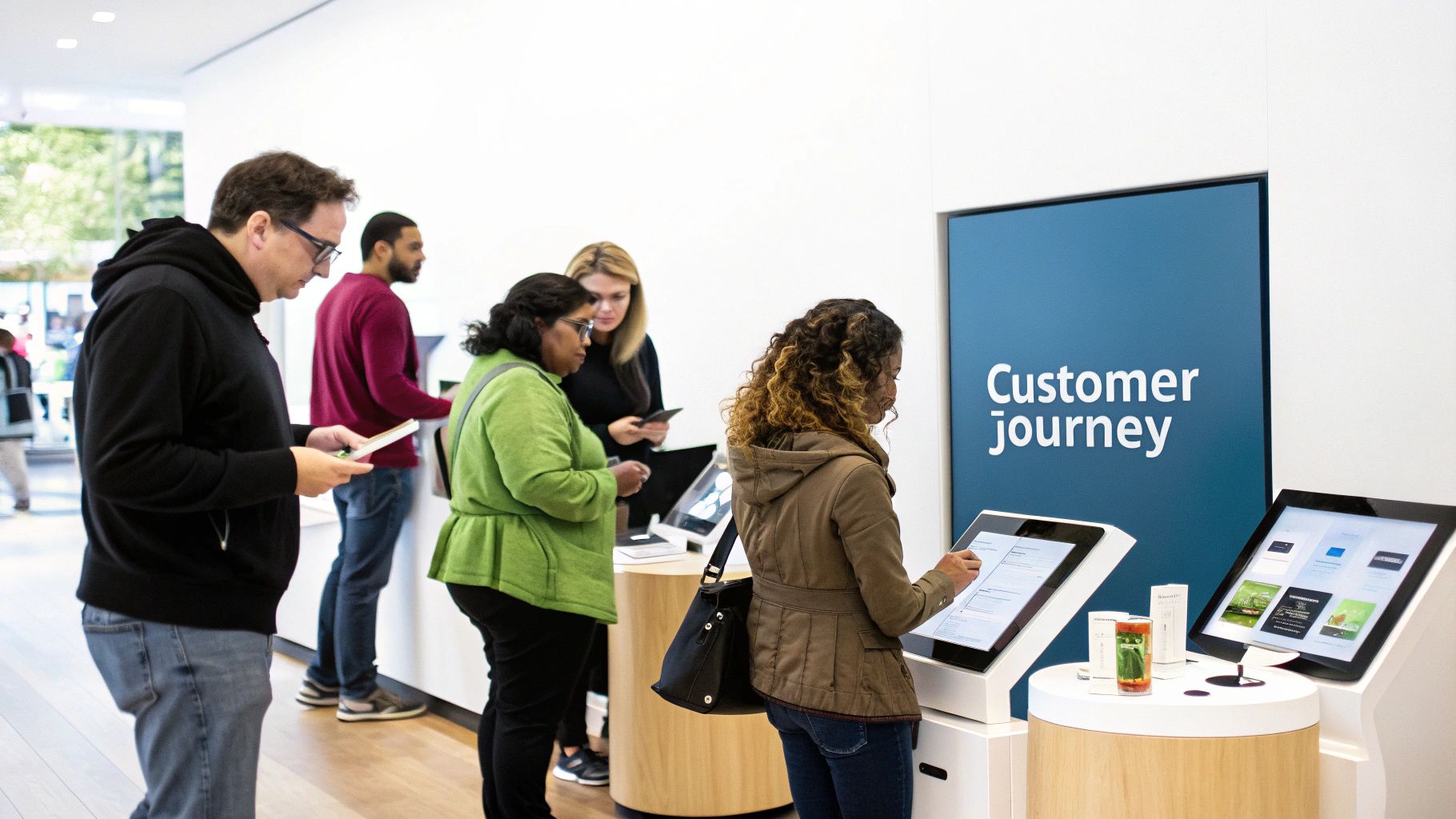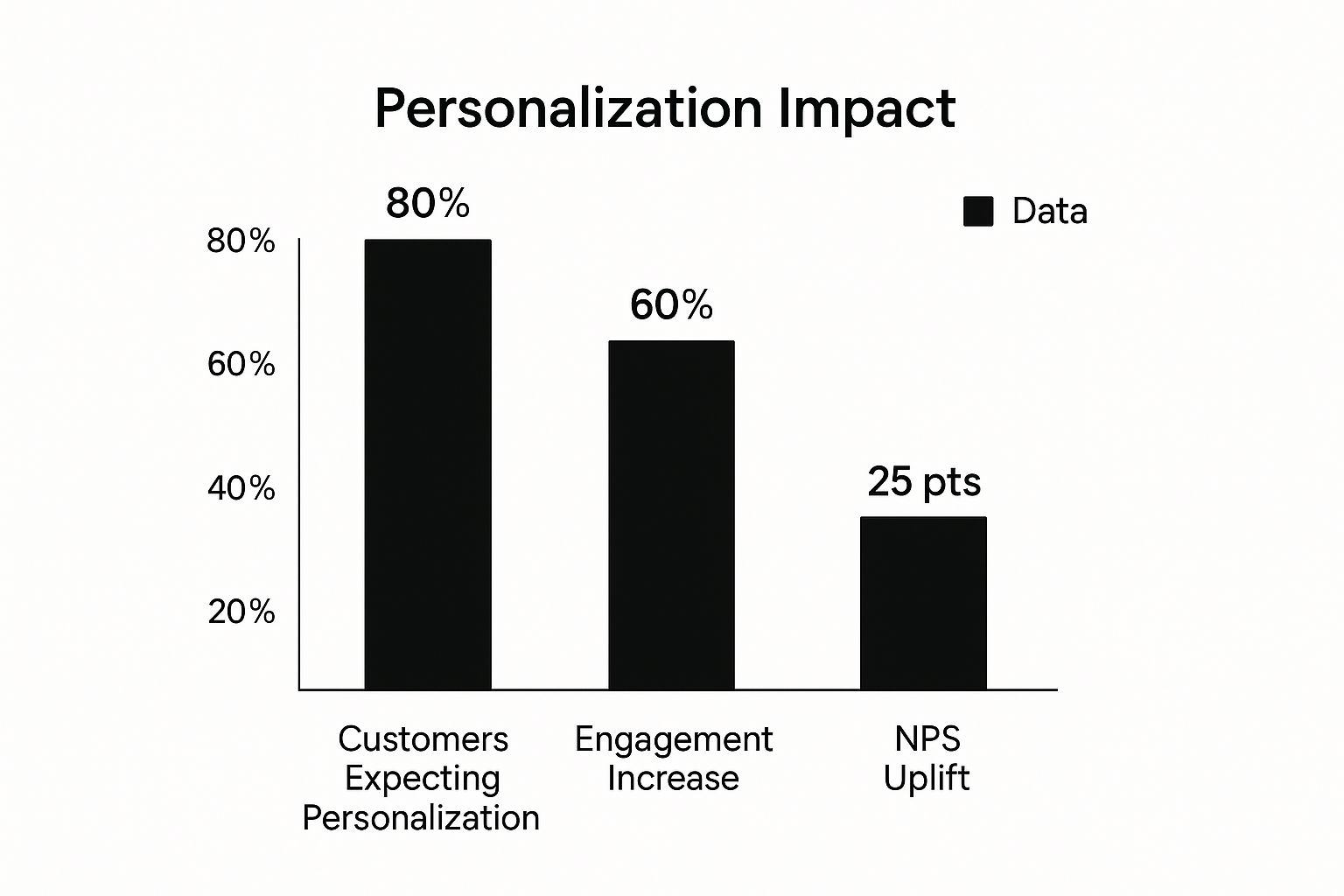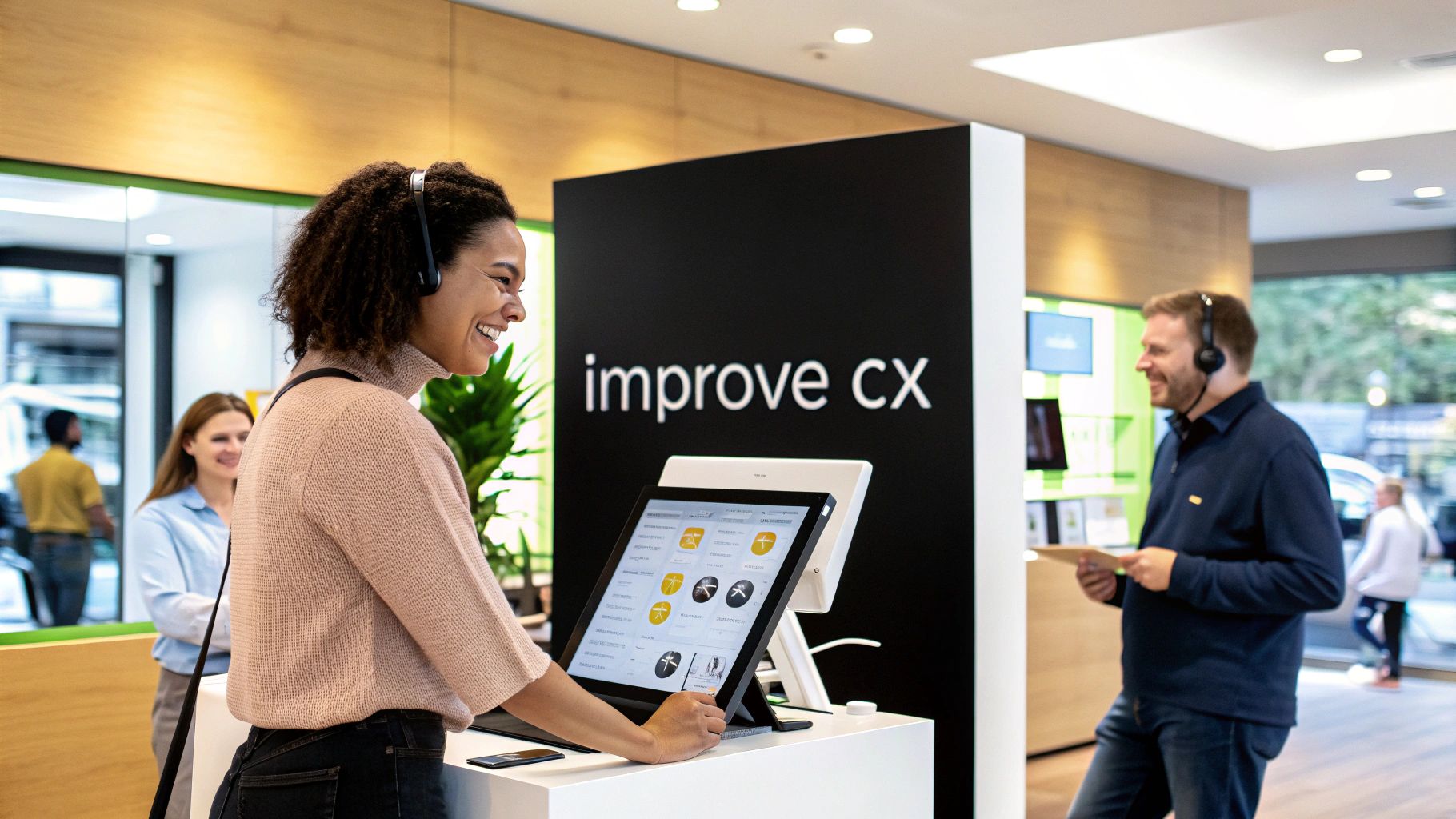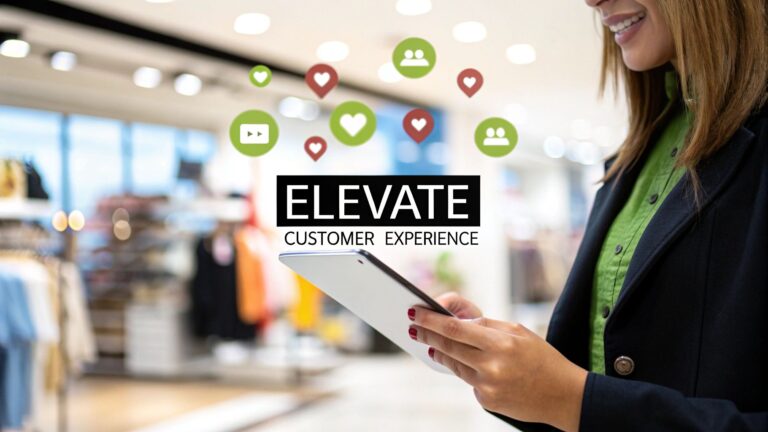Before you can even think about improving your customer experience, you have to do the groundwork. It all starts with truly listening to what your customers are saying—not what you think they're saying—and meticulously mapping out their entire journey with your brand. This means digging for direct feedback, getting to grips with their biggest headaches, and letting those insights drive every single decision you make. This isn't about guesswork; it's about building your strategy on a solid foundation of real-world evidence.
Building Your Foundation on Real Customer Insights

It’s a common trap: businesses often believe they're delivering a top-notch experience, but their customers see things very differently. The first real step is to close that gap. To do that, you need to get an unfiltered look at your business through your customers' eyes.
This isn't about relying on internal assumptions. It's about diving deep into what people actually think and feel when they interact with your brand at any stage. The best way to do this is by being proactive, collecting feedback across every channel you can to get the full picture.
Gathering Authentic Customer Feedback
You can't build a customer-centric business without a deep, genuine understanding of your customers. So, instead of just waiting for complaints to roll in, you need to actively go out and ask for their opinions. A smart approach involves mixing and matching different methods to capture a wide range of insights. To get a better handle on turning that data into strategy, have a look at this guide on Mastering Customer Experience Analytics.
Try bringing a few of these methods into your process:
- Targeted Surveys: Fire off short, simple surveys right after a key interaction. Think about what happens after a support ticket is resolved or a customer makes a purchase—a quick Net Promoter Score (NPS) question at that moment can tell you so much.
- One-on-One Interviews: Nothing beats a real conversation. Sit down with a handful of your most loyal customers—and maybe even a few who've had issues. Ask open-ended questions about their experience and what they'd love to see change.
- Social Listening: Keep your ear to the ground on social media. People are often brutally honest online, and monitoring mentions of your brand is a fantastic way to find candid, unsolicited feedback on what they love and what drives them mad.
Key Takeaway: Remember, the aim here isn't just to hoard data. It's about understanding the emotions that drive the feedback. In fact, more than 50% of an experience is rooted in emotion, and that directly influences how customers feel about you and whether they'll buy from you again.
Translating Data Into Actionable Tools
Once you’ve got all this raw feedback, you need to turn it into something your team can actually use. This is where the insights become a genuine strategic asset.
Start by creating detailed customer personas. These aren't just vague demographic profiles; they should represent your key customer segments, complete with their goals, what motivates them, and their common frustrations. For instance, you might create a persona called "Busy Ben," a small business owner who prizes speed and efficiency above everything else.
Next, you'll want to develop customer journey maps. These are visual roadmaps that chart every single touchpoint a customer has with your business—from their very first Google search right through to becoming a repeat buyer. Mapping this out is brilliant because it clearly shows you where you're delighting customers and, crucially, where the friction points are. This is the essential groundwork that allows you to improve your customer experience with precision and real impact.
Crafting a Truly Seamless Omnichannel Experience
Your customers don't see your business as separate departments or channels. To them, your website, your social media page, and your customer service line are all just you. A clunky handover between these touchpoints can be jarring, creating a frustrating experience that chips away at their trust. The real secret to a standout customer experience is making sure every interaction feels like a natural continuation of a single, ongoing conversation.
This often means tearing down the invisible walls that stand between your marketing, sales, and support teams. When these teams operate in silos with their own separate systems, it's the customer who pays the price, having to repeat their story over and over again. A great omnichannel strategy is one where a conversation that starts on live chat can be picked up on the phone by a support agent who has the full context right in front of them. No repetition, no fuss.
Unifying Your View of the Customer
To make this seamless journey a reality, your teams need a single source of truth—a unified view of every single customer. This is all about integrating your tech stack so that data from every touchpoint, from their browsing history on your site to past support tickets, is pulled into one accessible profile.
When you give your team this kind of visibility, they can stop being reactive and start being proactive. Imagine a customer abandons their online shopping basket and then calls for help. Instead of a cold start, your agent can see exactly what they were looking at and offer targeted, relevant assistance. It's a small change that makes a huge difference, solving the problem faster and making the customer feel genuinely understood.
This is where connected, personalised experiences really start to pay off, as the data shows.

As you can see, meeting customer expectations for a personalised journey directly boosts engagement and has a massive impact on loyalty, which is clearly reflected in the NPS scores.
Bridging the Digital and Physical Worlds
If you have a physical presence, connecting your online and in-store experiences is absolutely vital. An effective omnichannel approach makes the transition between these two worlds feel completely fluid and natural for the customer.
Building a solid omnichannel strategy involves several key components working together. Here's a breakdown of what that looks like in practice.
Key Components of an Omnichannel CX Strategy
| Component | Objective | Example Implementation |
|---|---|---|
| Unified Customer Profile | Create a single source of truth for all customer data across every channel. | Integrating CRM, e-commerce, and support platforms to show a customer's full interaction history in one dashboard. |
| Consistent Brand Experience | Ensure branding, messaging, and tone of voice are the same everywhere. | Using consistent design elements and language on the website, in-store signage, and social media posts. |
| Cross-Channel Inventory | Provide real-time visibility of product availability online and in-store. | An e-commerce site showing which local stores have a specific item in stock for immediate pickup. |
| Seamless Transitions | Allow customers to start a journey on one channel and finish on another without friction. | A customer adds items to a basket on their mobile app and can access that same basket on their desktop later. |
| Personalisation Engine | Use data to deliver relevant content and offers based on behaviour. | Sending a follow-up email with related products after a customer makes an in-store purchase using their loyalty card. |
By weaving these elements together, you create a cohesive experience that feels intuitive and reliable.
Some of the most effective strategies I've seen implemented include:
- Click-and-Collect Services: This is now a fundamental expectation. It gives customers the convenience of online shopping combined with the instant gratification of getting their product in-hand.
- In-Store Returns for Online Orders: Removing friction is key. Letting customers return an online purchase at a local shop is a massive win for convenience and builds confidence.
- Synced Customer Profiles: Linking a customer's online account with their in-store activity is a game-changer. It allows you to deliver genuinely personalised offers, no matter where they choose to shop. You can learn more by checking out the top 5 ecommerce trends shaping customer behaviour right now.
A recent UK Customer Satisfaction Index report found that 26% of UK customers now need to use more than one channel to complete a task. This clearly shows the demand for multichannel options. However, the report also warns that businesses must get better at protecting personal data to maintain customer trust. You can find more insights on the Institute of Customer Service website.
When you thoughtfully connect every touchpoint, you’re not just meeting modern expectations—you’re building a foundation for deep and lasting customer loyalty.
Using Technology to Personalise Every Interaction

These days, customers don't just appreciate being recognised; they expect it. The old tactic of dropping a first name into a mass email just doesn’t cut it anymore. Real personalisation is about anticipating what your customer needs before they even ask, offering something genuinely useful, and making every single interaction feel like it was designed just for them.
This is where tools like Customer Relationship Management (CRM) systems and Artificial Intelligence (AI) come into play. They're the engine that lets you deliver these one-to-one experiences at scale. Instead of relying on guesswork, you can tailor everything based on what people actually do—what they've bought before, the pages they lingered on, or even the support tickets they've raised.
Leaning into this data-driven mindset is the key to building a journey that people remember. When you truly understand a customer's history with your brand, you can serve them far better today and turn a simple purchase into a long-term relationship.
Harnessing Data for Smarter Interactions
Let’s be clear: the point of all this tech isn't to replace the human element, but to supercharge it. Think of a well-maintained CRM. It arms your team with the background story they need to have far more meaningful conversations. They can skip the repetitive questions and get straight to offering proactive, helpful solutions because the customer's history is right there in front of them.
Imagine this for a moment. A loyal customer who always buys from a particular product range lands on your website. An AI-powered system can immediately spring into action:
- It could recommend new arrivals that perfectly match their previous purchases.
- The homepage could instantly rearrange itself to highlight the categories they love most.
- It might even trigger a timely email with a small discount on an item they looked at last week but didn't buy.
This isn't just about good service; it's smart business that shows you're paying attention. By making the experience more relevant, you're not only boosting customer satisfaction but also your bottom line. This kind of targeted approach is a huge part of effective ecommerce conversion rate optimisation.
Bridging Online Behaviour with In-Person Experiences
Across the UK, the line between online and in-store shopping is blurring. Customers now expect their digital footprint to follow them into the physical world. If they’ve added a few items to their basket on their phone, they want a store assistant to have that insight when they walk through the door.
Recent research really drives this point home. A 2025 study revealed that 71% of UK consumers get frustrated by impersonal shopping experiences, and almost half have switched brands over it. This pressure is pushing UK retailers to invest in technology that weaves every touchpoint into a single, seamless conversation with the customer. You can read more on how UK retailers are transforming CX to get the full picture.
Key Takeaway: A disjointed experience is a deal-breaker. Customers see things like AI and omnichannel support as standard, not as novelties. Retailers who fail to connect the dots are going to lose out to those who deliver the smooth, integrated journey that modern shoppers demand.
Ultimately, technology-driven personalisation is about making the customer feel so completely understood that the experience feels effortless. It’s about showing each individual that they matter, which is still the most powerful way to build loyalty and grow your business.
Here is the rewritten section, designed to sound like it was written by an experienced human expert.
Turn Your Team into CX Champions
Let's be honest, all the fancy tech and slick processes in the world don't mean a thing if the people delivering the experience aren't on board. At the end of the day, your team is your single greatest asset for creating those standout customer moments. This is all about the human side of great service—transforming your frontline staff into genuine champions for your customers.
When your team has the freedom to solve problems on the spot, everything changes. Instead of getting tangled in red tape or robotically reading from a script, they can use their own judgement to turn a potential disaster into a moment that builds real loyalty. This all comes down to a culture of trust, and it has to start at the top.
Build a Truly Customer-First Culture
A customer-centric culture isn't just a slogan you stick on the wall. It’s a way of thinking that should be woven into every single decision your business makes. It means everyone, from the CEO right down to the newest intern, understands how their work fits into the customer's journey. This shared purpose makes improving the customer experience a team sport, not just a task for the support department.
So, how do you actually build it? By investing in practical skills.
- Empathy Training: Forget the textbook definitions. Use role-playing with real-life customer problems to help your team feel what the customer is feeling. There’s a world of difference between a scripted apology and a team member who can genuinely say, "I can see why that's so frustrating." It's an instant de-escalation.
- Active Listening Skills: Train your people to listen to understand, not just to reply. This is about repeating the customer's issue back to them to show you're on the same page ("Okay, so to make sure I've got this right, the delivery is missing and you need it before Friday?") before you even think about a solution.
From my experience: More than 50% of any customer experience comes down to emotion. An employee who can connect with a customer on a human level will always outperform someone who's just ticking boxes.
Give Them the Right Tools and the Freedom to Use Them
You can't empower a team without giving them the tools for the job and the authority to act. This means, at a minimum, giving them a single view of the customer so they aren’t asking the same questions over and over again. It also means trusting them to make things right.
Think about it: can your frontline staff offer a small discount, rush a shipment, or apply a credit without needing three layers of management approval? When they can, problems get solved in minutes, not days, and customer satisfaction skyrockets.
To keep everyone sharp and spot areas for growth, you can introduce tools for ongoing improvement. A great starting point is to learn how to design effective call center quality monitoring forms. These aren't for catching people out; they're for identifying coaching opportunities and celebrating wins.
Ultimately, investing in your team’s skills is a fundamental part of building a strong brand—and that’s a cornerstone of any successful digital marketing for small business plan. When your team feels valued and trusted, that confidence shines through in every single conversation, making your customers feel valued too.
Delivering the Speed and Responsiveness Customers Expect

In our always-on world, patience is a virtue in seriously short supply. Let's be honest: customers don't just hope for a quick reply anymore; they see it as part of the deal. If you're slow to respond, you're not just making them wait. You're sending a clear signal that their time, and their business, isn't a priority.
Every single delayed response—whether it's on social media, live chat, or email—is a point of friction. That friction builds up fast, turning a simple question into a major headache and potentially souring a great customer relationship for good. The trick isn't just about being fast; it's about being fast and effective. A quick reply that solves nothing is just noise.
Meeting Modern UK Consumer Expectations
The rise of eCommerce in the UK has put this demand for speed into overdrive. With online retail now accounting for over 27% of all retail sales in Great Britain, the pressure on digital customer service teams is immense. During peak periods like Black Friday or Boxing Day, that pressure cooker really heats up.
It’s no surprise, then, that 67% of UK shoppers now expect a response to their query within two hours. This reality calls for a truly joined-up approach, where a message on WhatsApp gets the same urgent attention as an email. You can discover more insights about UK customer service trends on edesk.com.
To keep up, you need to set clear, realistic benchmarks for your team. Here’s what I’ve found works:
- Live Chat: Aim for an initial response in under 60 seconds. This is a real-time conversation channel, and long pauses feel incredibly jarring.
- Social Media: A reply within 1-2 hours is the new benchmark. These are public forums, so a swift response can prevent a small issue from escalating.
- Email: Even on this more traditional channel, customers expect a full resolution within 24 hours, with an initial acknowledgement coming through much, much sooner.
Key Takeaway: Speed without substance is a waste of everyone's time. Your processes must be geared towards making sure that first, fast response is also the right one. Rushing to give the wrong information just creates more work and chips away at trust.
Streamlining Your Service with Integrated Platforms
Often, the biggest barrier to a speedy response isn't your team's effort—it's internal chaos. When your customer service tools are siloed and don't speak to each other, your agents waste precious minutes hunting for information across different systems. It's inefficient for them and deeply frustrating for the customer who has to repeat their story over and over again.
This is where a single, integrated service platform really proves its worth. By pulling all customer conversations from every channel into a unified inbox, you give your team the complete picture instantly. No more flicking between tabs or asking repetitive questions.
Imagine a major sales event. An integrated system prevents enquiries from falling through the cracks or being answered twice by different agents. Every customer gets a timely, informed reply because the context is right there. This kind of setup allows you to build an operation that's consistently fast, organised, and genuinely helpful, turning responsiveness from a daily scramble into a real competitive advantage.
Common CX Questions Answered
Diving into customer experience improvements can bring up a lot of questions. Even with a great plan in place, you’ll inevitably hit specific roadblocks that feel tricky to navigate. Here, I'll tackle some of the most common queries I hear from UK businesses, offering some straightforward advice to help you push past these hurdles.
It's no surprise that the first question is almost always about the return on investment. It's a perfectly valid point – you're putting time, effort, and money into this, so you need to see a real business impact.
How Do You Measure the ROI of CX Efforts?
Measuring the return on your customer experience work isn’t as fuzzy as you might think. It’s really about connecting the dots between how customers feel and act, and your company's financial health. You need to look at the hard numbers that move when customer satisfaction goes up.
I always advise clients to start by tracking these key performance indicators:
- Customer Lifetime Value (CLV): This is a brilliant metric. It calculates the total revenue you can expect from a single customer account. Simply put, happier customers tend to stick around longer and buy more from you.
- Customer Churn Rate: Keep a close eye on the percentage of customers who stop using your service. A drop in churn is a direct financial win. After all, everyone knows it costs far less to keep a customer than to find a new one.
- Net Promoter Score (NPS): This one’s a classic for a reason. It directly asks customers how likely they are to recommend your business. Study after study has shown that companies with a higher NPS tend to outgrow their competitors.
One piece of research found that customers who had a great experience spend 140% more and stay loyal for up to six years. That’s a crystal-clear link between a better customer journey and more revenue.
How Should You Handle Negative Online Reviews?
Getting a bad review can sting, there's no doubt about it. But how you react is what really defines the situation. Burying your head in the sand is the worst thing you can do. Instead, try to see it as a raw, unfiltered piece of feedback and a chance to show everyone what your company is made of.
The playbook here is to act fast, respond publicly, and lead with empathy. Acknowledge their complaint, apologise that you didn't meet their expectations, and then offer to take the conversation offline to sort it out properly. That public response isn't just for the unhappy customer; it shows every potential customer reading it that you take service seriously. It can genuinely build trust.
Where Should You Start with a Limited Budget?
You don't need a massive budget to start making a real impact. If you're working with limited resources, the key is to focus on changes that deliver the most bang for your buck. The best place to begin? Simply get better at listening.
Start by sending out short, focused feedback surveys after key moments in the customer journey. Tools like SurveyMonkey or even a simple Google Form cost very little but give you a goldmine of information about your customers' biggest frustrations. Another powerful, low-cost strategy is to invest in your team. Train them on active listening and give them the autonomy to solve customer problems right there and then. Often, the biggest gains come from tweaking your culture, not buying new tech.
At Ibertech Solutions Limited, we specialise in creating seamless digital experiences that your customers will love. From bespoke website design to strategic SEO, we build the foundations for exceptional customer journeys. Let's discuss how we can help you grow your business at https://www.ibertechsolutions.co.uk.





